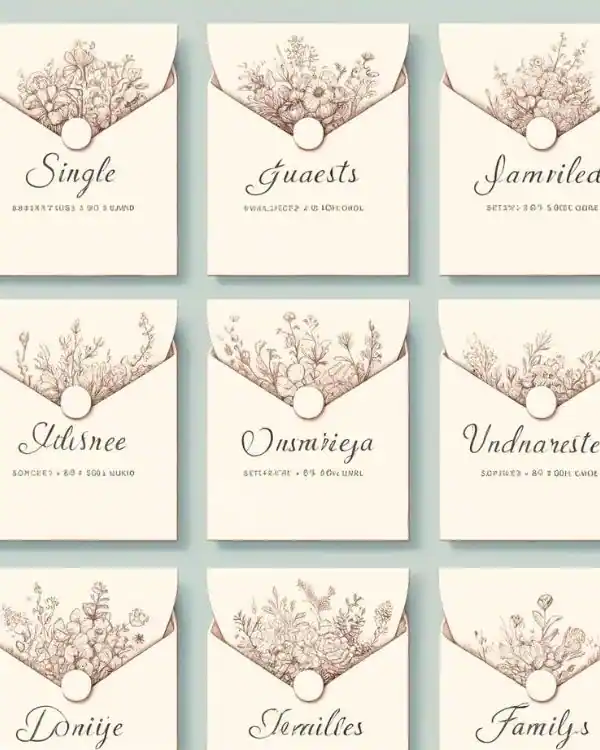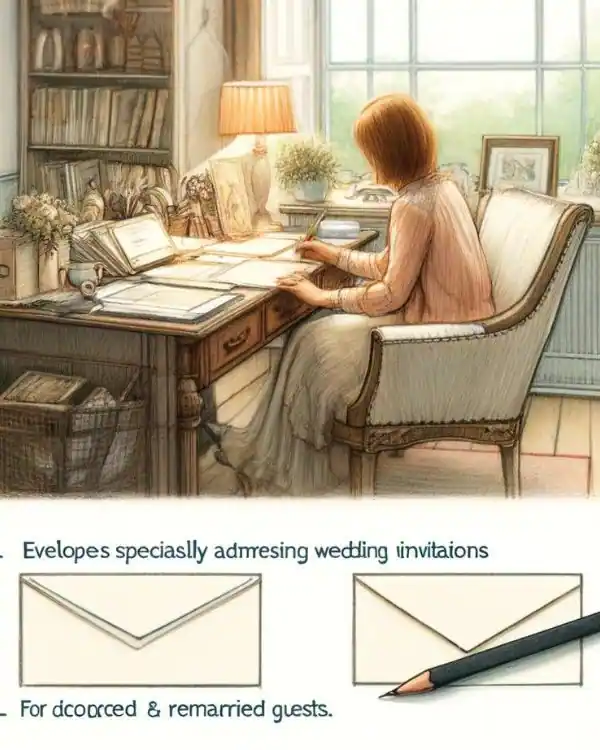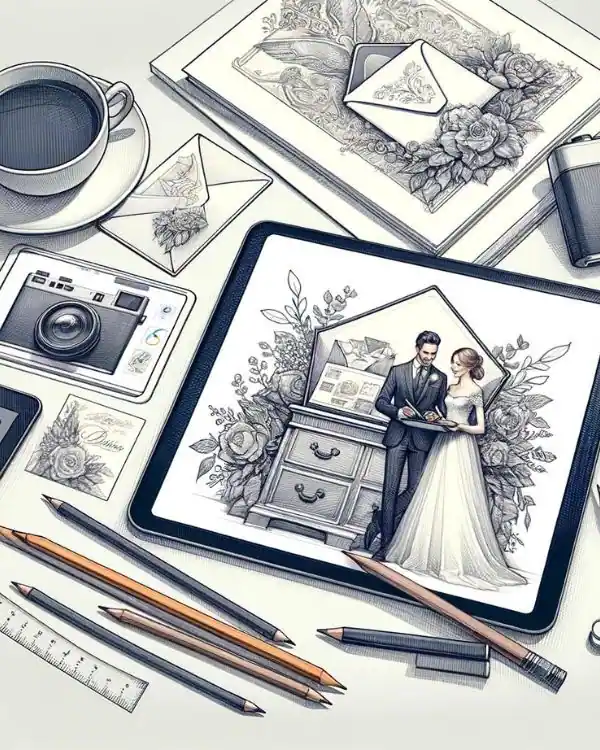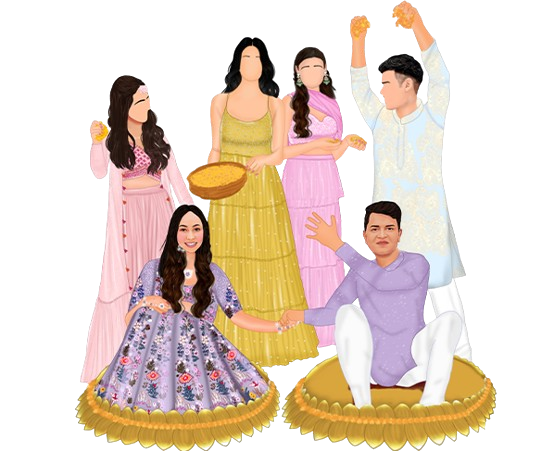Advertisement
By IS Team
The Ultimate Guide To Writing Names On Wedding Envelopes: Do’s And Don'ts

Advertisement
When addressing wedding invitation envelopes, it's essential to blend tradition with personalization. Always use full names with appropriate titles, reflecting respect and formality.
For couples, adapt your approach based on their marital status, and for families, use phrases like "and Family" to include everyone. Acknowledge diverse cultural backgrounds by respecting naming conventions and titles specific to each culture.
Lastly, ensure legibility and correctness by choosing a readable font and double-checking each name and address. By meticulously crafting each envelope, you convey warmth and appreciation, making every guest feel truly valued and eagerly anticipated at your celebration.
Understanding Wedding Invitation Etiquette

Wedding invitations are more than mere notifications of an upcoming event; they are a celebration of tradition and a personal touchpoint for each guest. Understanding the etiquette surrounding how these invitations are addressed can profoundly impact the perception and tone of your wedding. It’s not just about following rules—it’s about crafting an experience that begins at each guest’s mailbox.
The Significance of Etiquette in Wedding Invitations
The way you address your wedding invitations does more than inform—it conveys respect, honor, and personal consideration. Etiquette helps navigate the social complexities that might arise, ensuring that every guest feels valued and respected. This care sets the stage for a harmonious celebration, reflecting the thoughtfulness of the hosts. Proper etiquette also upholds the formality of the occasion, aligning the style of your invites with the overarching vibe of your wedding day. 🌟
General Rules for Writing Names
When it comes to writing names on wedding invitations, a few key guidelines will help you maintain clarity and decorum:
- Use Full Names: Avoid nicknames or abbreviations. Using a guest’s full name not only respects their identity but also adds a formal touch to your invitation.
- Include Titles Where Appropriate: Titles (Mr., Mrs., Dr., etc.) are not just formalities but are important indicators of respect, especially for guests who are professionals or hold a significant position in society.
- Acknowledge Relationships: For couples, families, and significant others, ensure the way you address them reflects their relationship. This might mean deciding between "Mr. and Mrs. John Smith" and "John and Jane Smith" based on the couple's preference or marital status.
- Honor Cultural Titles: If you are inviting guests from different cultures, consider how their names and titles are traditionally formatted. This shows immense respect for their heritage and can mean a lot to your guests.
- Consistency is Key: Keeping a uniform format across all envelopes not only looks neat but ensures that no guest feels out of place. This consistent approach speaks to the organizational prowess and attention to detail of the hosts.
By adhering to these principles, you ensure that each envelope you send out is a bearer of goodwill and anticipation. Remember, the invitation is the first glimpse your guests will have of your wedding—it should be as welcoming and graceful as the event itself. ✨
Formats for Addressing Envelopes

Crafting the perfect wedding invitation envelope requires a blend of formality and personal touch. Here’s how you can address your envelopes with style and respect, ensuring every guest feels personally invited to your celebration.
Single Guests: How to Address Invitations to Individuals
For single guests, use their full name with an appropriate title. This demonstrates respect and consideration, making each individual feel acknowledged. For example:
- Mr. John Smith
- Ms. Jane Doe
It’s polite and inclusive to use titles like "Ms." or "Mr." unless you know the guest prefers a different form of address or title.
Couples: How to Address Married, Unmarried, and Same-Sex Couples
The way you address an envelope to a couple can convey both respect and recognition of their relationship:
- Married Couples with the Same Last Name: Use "Mr. and Mrs. John Smith." This traditional format is simple and elegant.
Unmarried Couples Living Together: Write each person's name on a separate line, in alphabetical order by last name:
- Ms. Jane Doe
- Mr. John Smith
Same-Sex Couples: Similar to unmarried couples, use alphabetical order if they do not share a surname, or the traditional married format if they do.
Families: Addressing Families with Children
When inviting entire families, the envelope can be addressed to the parents, with “and Family” to include children under 18 living at home:
- The Smith Family
- Mr. and Mrs. John Smith and Family
This approach ensures the invitation feels inclusive to all members of the family.
Titles and Professional Ranks: Handling Titles Such as Dr., Judge, etc.
Professional titles should be acknowledged, as they respect the guest’s achievements and status:
- Doctors: Use “Dr.” For couples where both are doctors, you can address them as “Drs. Jane and John Smith” or “Dr. Jane Doe and Dr. John Smith.”
- Judges, Military Personnel, Religious Leaders: Use their formal title followed by their name. For example, “Judge John Smith” or “Reverend Jane Doe.”
Always place the professional title before the personal title unless the guest has indicated a preference for a different form of address. This acknowledgment not only honors their professional identity but also adds a layer of personalization to your invitations.
By adhering to these guidelines, your wedding invitations will convey warmth and respect across a spectrum of social and professional contexts, setting a tone of elegance and celebration for your upcoming wedding. 🎉
Special Considerations

When addressing wedding invitation envelopes, it's crucial to navigate special situations with sensitivity and respect. Here’s how to handle some common but delicate scenarios:
Addressing Divorced and Remarried Guests
When addressing invitations to divorced and remarried guests, it is important to use their current name and include any new spouse if applicable. If you're unsure, it's entirely appropriate and respectful to ask how they would prefer their names to be addressed. For example:
- Ms. Jane Doe (if reverted to maiden name)
- Mr. John Smith and Mrs. Jane Smith (if remarried)
This consideration ensures that each guest feels valued and respected, reflecting their current life situation.
Inviting Guests with Distinguished Titles (Military, Religious, etc.)
Guests with distinguished titles bring a level of formality and honor to your event. It’s crucial to use their correct title and rank, showing both respect and acknowledgment of their positions:
- Captain John Smith, US Navy
- Rabbi Jane Doe
When in doubt, opting for a more formal address is a safe and respectful choice, acknowledging their contributions and status in society.
Handling Variations in Family Structures (Stepfamilies, Half-Siblings)
Modern families often include stepfamilies and half-siblings, and addressing such family structures thoughtfully can make everyone feel included. Consider the following:
- Use the primary caregiver's name first if addressing younger children, and include stepchildren by listing them after biological children, all under the “and Family” banner.
- For adult stepchildren or half-siblings who no longer live at home, sending separate invitations is a thoughtful gesture that recognizes their independence and personal family status.
Example:
- Mr. John Smith and Mrs. Jane Smith and Family
(Includes John’s children and any children Jane may have from a previous relationship who live at home.)
This approach not only respects the complexity and diversity of modern families but also celebrates the inclusivity of your joyous occasion.
By taking these special considerations into account, you ensure that your wedding invitations are a prelude to a celebration where every guest feels genuinely respected and eagerly anticipated. This level of personalized attention can significantly enhance the communal and festive spirit of your wedding day. 🌟
Cultural Considerations
In our global society, weddings often bring together guests from diverse cultural backgrounds. Respecting these differences through the way you address your invitations can add a rich layer of personalization and inclusivity to your event. Here’s how you can honor cultural norms and preferences in your wedding invitations:
Addressing Guests from Different Cultural Backgrounds
Understanding and respecting the cultural nuances of naming conventions is key. Some cultures place the family name before the personal name, and some may use titles not commonly seen in Western traditions. For example:
- In many East Asian cultures, the family name is written first (e.g., "Kim Ji-soo" should be addressed as "Ms. Kim").
- In Hungarian and other Eastern European cultures, the family name also precedes the given name.
When addressing invitations to culturally diverse guests, consider:
- Researching or asking about proper etiquette in their culture. This not only shows respect but also your interest in their heritage.
- Using bilingual invitations if a significant number of guests speak another language, which can make the invitations more accessible and appreciated.
Examples and Tips for Various Cultural Norms
- Spanish and Hispanic Cultures: Use full names including middle names, and for married women, it's common to use both maiden and married surnames.
- Indian Cultures: It’s customary to include the names of both spouses on an invitation and sometimes even the names of the parents, especially for formal events like weddings.
- Middle Eastern Cultures: Titles are particularly important, and using them correctly shows a deep level of respect.
Practical Tips:
- Confirm the preferred address and title with the guests themselves or family members to avoid any cultural faux pas.
- Consider the formality of your event when deciding how traditional your approach should be, as some cultural traditions are quite formal.
By integrating these cultural considerations, your wedding invitations will not only be a form of communication but also an expression of global respect and unity. This thoughtful approach ensures that all your guests feel welcomed and valued, setting the stage for a truly inclusive celebration. 🌍💖
Typography and Presentation
The visual impact of your envelopes sets the stage:
Choosing the Right Font and Text Size
Selecting the appropriate font and size is essential to ensure that your invitations are as readable as they are aesthetically pleasing. Consider these points:
- Serif vs. Sans Serif: Serif fonts, such as Times New Roman or Garamond, have small lines at the ends of strokes, lending a classic and formal look. Sans serif fonts like Helvetica or Arial offer a cleaner, more modern appearance.
- Font Size: Generally, a font size between 12 and 16 points works well for readability while keeping your text aesthetically pleasing.
Script vs. Print: What Works Best for Formal Invitations?
- Script Fonts are elegant and traditional, perfect for formal or classic weddings. They add a touch of sophistication and are often used for the names of the invitees to highlight their importance.
- Print Fonts are best for more contemporary weddings or for any details on the invitation where clarity is paramount, such as the address or RSVP information.
When deciding between script and print, consider the overall style of your wedding and the level of formality you want to convey. Using a combination of both might also be effective: script for the names and print for the details.
Tips for Ensuring Legibility
Ensuring that your invitations are legible not only makes them more functional but also shows consideration for your guests. Here are some tips to enhance readability:
- High Contrast: Make sure there is sufficient contrast between the text color and the envelope color. Dark text on a light background is typically the most readable.
- Spacing: Adequate spacing between letters and lines can significantly improve the legibility of script fonts in particular. Avoid crowding the text.
Test Prints: Before finalizing your invitations, print a few test copies to see how the text appears on paper. This can help you catch any issues with font size or legibility.
Avoid Overly Decorative Fonts: While tempting, overly decorative fonts can be difficult to read. If you choose a decorative style for names, keep the rest of the text in a more straightforward font.
By carefully considering these aspects of typography and presentation, you ensure that your wedding invitations are not only visually stunning but also warmly inviting and easy to read. This attention to detail will certainly be appreciated by your guests and can set a respectful and considerate tone for your upcoming nuptials. 💌✨
Digital Alternatives

Digital invitations offer a modern twist on traditional wedding invites, combining classic etiquette with the benefits of technology.
Mimicking Traditional Envelope Addressing
- Customizable Templates: Choose designs that mimic the elegance of paper invitations.
- Virtual Calligraphy: Use digital fonts that resemble handwritten script for a personal touch.
- Interactive Features: Incorporate elements like RSVP buttons for easy guest management.
Benefits of Digital Envelopes
- Eco-Friendly: Reduce paper use and environmental impact.
- Cost-Effective: Save on printing and postage costs.
- Convenient: Send and manage invitations instantly, with easy tracking of RSVPs.
- Accessible: Reach guests globally without delay.
Digital invitations seamlessly blend tradition with modern efficiency, making them an ideal choice for contemporary weddings.
Common Mistakes to Avoid
When preparing wedding invitations, certain pitfalls can detract from the elegance and personal touch of your invites. Here’s how to sidestep common errors and ensure your envelopes are flawlessly presented.
Frequent Errors in Addressing Wedding Envelopes
- Misspelling Names: A simple misspelling can make a guest feel overlooked. Always double-check the spelling against your guest list.
- Incorrect Titles: Misusing or omitting titles can be seen as a lack of respect or attention to detail. Ensure titles like "Dr.," "Judge," or military ranks are correct.
- Outdated Information: Sending invitations to old addresses leads to delays or lost invites. Confirm current addresses before mailing.
- Overlooking Plus-Ones: Failing to address invited plus-ones can create awkward situations. If included, make sure to address the envelope to "Mr. John Smith and Guest."
Tips for Proofreading and Double-Checking Addresses
- Create a Checklist: Before sealing any envelope, use a checklist for names, titles, and addresses to ensure nothing is missed.
- Ask for Help: A fresh pair of eyes can catch errors you might overlook. Have a family member or friend review the invitations.
- Use Digital Tools: Leverage address verification tools or software to confirm the accuracy of addresses.
- Print a Sample: Before finalizing your entire batch, print a sample to check for any visual or textual errors.
By paying close attention to these details, you can avoid common mistakes that might mar the first impression of your wedding. Remember, your invitation is the first glimpse guests will have into your celebration, so make it count!
Frequently Asked Questions
Can I use colored ink for addressing wedding invitation envelopes? Yes, colored ink can be used to add a personal touch, but choose shades that maintain readability and match the overall color scheme of your wedding invitations.
Should I use stickers or labels for addressing envelopes? While hand-addressing adds a personal and traditional touch, printed labels can be used for a clean and uniform appearance, especially if you have a large guest list.
How should I address an envelope to a widow or widower? It is respectful to address a widow as Mrs. John Smith, but if you know they prefer to use their first name, it’s perfectly acceptable to address them as Mrs. Jane Smith.
What is the best way to handle invitations for diplomats or other government officials? Diplomats and high-ranking officials should be addressed by their official title followed by their full name, such as "His Excellency John Smith" or "The Honorable Jane Doe."
Advertisement
I'm Looking For!




.png)
.png)
.png)

